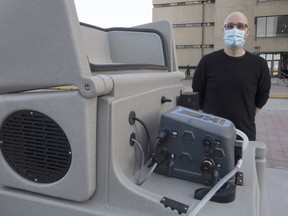“There is some good news that it is stabilizing, but it is still at a high level.”

.
Omicron’s BA.4 and BA.5 subvariants are now dominant in Ottawa, according to researchers who monitor the city’s wastewater.
Announcement 2
.
Omicron subvariants, first identified in South Africa in April and reported to be increasing worldwide, have been increasing in Ottawa sewage since early July, said Robert Delatolla, a professor of environmental engineering at the University of Ottawa.
BA.4 and BA.5 now account for about 90 percent of the dominant sublineages in the city’s wastewater, said Delatolla, who is a member of the team that developed an innovative process to detect the virus in the sewer system and is monitoring their presence. .
While the test results have combined the two subvariants, it appears that BA.5 is the predominant subvariant, he said.
The good news is that the viral signal of the amount of BA.4 AND BA.5 in wastewater, which is related to the number of people infected, has stopped increasing. That presents the possibility that it could fall.
Announcement 3
.

“Does that mean it has peaked? We can’t say for sure. But it has leveled off,” said Delatolla, who noted that the current data suggested a similar pattern to previous waves of infection earlier this year, which peaked and plateaued in January and April.
“There is some good news that it is stabilizing, but it is still at a high level,” he said.
“There is still quite a lot in the community, but the positive side is that it is stabilizing. There is a possibility that it will fall off. But there are no guarantees.
Reports suggest that BA.4 and BA.5 infections are spiking in countries around the world because the variants are spreading faster than others currently in circulation.
Last week, the White House announced that BA.4 and BA.5 made up 80 percent of COVID-19 cases in the United States and warned that “early indications indicate that BA.5 may have a greater ability to escape immunity, even from previous infections, which means it has the potential to cause the number of infections to rise in the coming weeks.”
Announcement 4
.
On Friday, Canada’s chief public health officer, Dr. Theresa Tam, said some Omicron sublineages had shown a growth advantage and additional immune escape over previous sublineages.
“While the precise impacts are unknown, it is reasonable to expect that we may see a continued increase in the number of cases in the coming weeks, particularly as a result of Omicron’s BA.5 sublineage increasing in proportion among viruses sequenced,” he said. Tam. she said in a statement.
But BA.4 and BA.5 also appear to be causing fewer deaths and hospitalizations.
During the peak of the wave in January, when Omicron’s BA.1 subvariant was dominant, there were 139 people with confirmed COVID-19 in Ottawa hospitals, including 19 in intensive care units. At the peak of the wave in April, dominated by the BA.2 subvariant, there were 48 people in the hospital and six in the ICU.
ad 5
.
On Tuesday, Ottawa Public Health reported 32 people in hospital with active infections, including three in the ICU.
uOttawa’s research team has been tracking COVID-19 in wastewater since the start of the pandemic.
A significant proportion of people with active COVID-19 infections shed the coronavirus in their feces, which sheds the virus into the sewage system, sometimes even before symptoms appear.
Ottawa’s Robert O. Pickard Environment Center collects and treats wastewater from nearly 92 percent of Ottawa’s population, allowing the team a centralized way to measure levels of coronavirus genetic material and track strain variants. interest and concern.
Wastewater results are reported daily and on file with the Ottawa Department of Public Health.
The reporting system is being updated and the numbers may take several days to become public. Reporting five days a week will resume in the coming weeks, Delatolla said.
